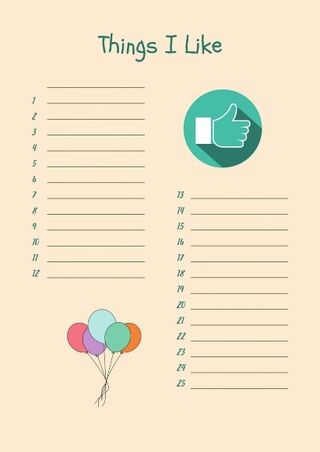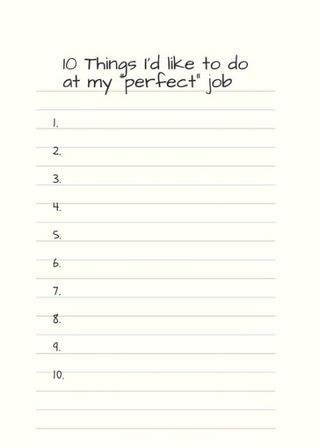Career
The Career-Boosting Power of Lists
Such a simple technique. Such powerful results.
Posted March 29, 2019
When thinking about what to do next in your career or conducting a job search, it’s easy to get overwhelmed by all the information and details. Sometimes the use of visual organizers to sort and manage the informational clutter can bring clarity to the confusion. This post focuses on arguably the simplest of organizers: the list.
You already use lists all the time, probably without giving them much thought. Take a simple activity like grocery shopping. If you only have to pick up an item or two, you’re fine without a list. But when you’re trying to get the correct ingredients for a recipe or do a week’s worth of shopping, a list will increase the likelihood that you come out with the correct items and won’t forget anything.
Lists are a great way to clarify your thoughts, uncover new information, learn what’s important, make decisions, and organize your plans. Getting all your ideas onto a list can help you organize them and develop action plans. They can also help you deepen your understanding of what motivates you. You're probably familiar with gratitude lists and bucket lists, for example.
Lists can also make you feel quite productive. Is there any better feeling at work than crossing off an item from your to-do list?
Before we get started, here are some suggestions for your list-making:
- Consider removing the numbers from your list if you find them distracting. We tend to assume that the most important item needs to be the #1 item on the list. The truth is, sometimes the last few items on your list can be the most significant because they are thoughts and ideas that bubble up to the surface after you’ve already written the obvious thoughts you started with. As you keep thinking and pushing yourself to come up with 20 responses, you are more likely to uncover some gems at the end of your thoughts. So don’t censor yourself or worry about numbers and feel free not to use numbers on your list at all.
- Push yourself beyond your “list limit.” It’s usually easy to come up with 5-10 responses to a prompt, but you’ll have to push yourself to list 20 or 25 items. Do it. The more you push yourself (even when you think some of your responses are silly), the more likely you will find a treasure in the weeds.
- Keep your list accessible throughout the day (and night!) so you can add to it when inspiration strikes. Even though you think you have completed your list, your subconscious mind will continue to work on it.
Let's start with two Deceptively Simple Career Enhancing Lists. I call these lists “deceptively simple” because you’re likely to look at them and think, “Well, this is silly. I know how to make lists.” Of course you do. But trust me—these “deceptively simple” lists will reveal more secrets than you realize. You’re going to have a new respect for the power of lists shortly. So let’s start.
List #1: What Do I Like?
You can’t get more basic than this list: "What do I like?" Sometimes this list confuses people because it doesn’t focus specifically on careers. “Why would I need to make a list of what I like? My interest in guitars has nothing to do with my career plans,” you might be thinking. The “What do I like” list has a number of purposes, but the main purpose is to bring to light what you enjoy, what makes you happy, what interests you. So start by just making a list of 20 or so items that you like. This list can include favorite colors, performers, movies, hobbies, locations, vacations, etc. Don’t worry about whether it’s “practical” or “career-related.”
In the introduction to her book It’s Never Too Late to Begin Again, Julia Cameron described making a list of twenty-five things she loves, only to discover that high on her list were items related to the Southwest—and yet she was living in New York City. She ended up moving to Santa Fe to start a new life at age 64. That’s one powerful list.
So give it a try, and make your list before you read further.

Time to analyze your list. Pretend someone else wrote this list you’re looking at: What do you know about them? How would you describe their interests? Are there any themes or similar items showing up? What would you tell this person about the list?
Here are some questions to ask yourself:
- What does your list say about you?
- Did anything on your list surprise you?
- Is there anything on the list you used to like but haven’t done recently? Why? Would you like to start doing it again?
- Could (or do) any of these items relate to your work?
- Is there a way to monetize or derive income from anything on the list?
- Are you action-oriented or do you prefer slower-paced activities?
- Are many of your “likes” expensive (hobbies like sailing, for example)? What does that say about the income you will need from your work?
- Are you primarily an indoor or outdoor person based on your interests?
- Is there a geographic pattern based on your list? Do you seem drawn to other countries or other locations?
If you found making this list helpful, or if you found yourself veering in another direction, try creating lists based on these variations and ask yourself the same questions as above:
- What am I interested in?
- What do I like to do?
- How do I prefer to spend my time?
Take note of what you have learned: this simple list can awaken forgotten interests and strengths that might point the way to your next job or career or even geographical location.
Let’s try a list that is more directly related to working:
List #2: My Perfect Job
Whether you’re just entering the workforce and considering what your first job might be like, or you’ve been working for a while and are eager to find something that better fits your needs, the “My Perfect Job” list is a great way to start dreaming about your future. Try listing 10 or so things that you would like to do at this perfect job. Once again, don’t censor yourself and keep it honest. It’s OK to have fun with this—even things you put down in jest might ultimately become part of your job. Make your list using the sample here.

Now that you have completed your list, you can start analyzing it for ideas.
Let’s take a look at a sample “perfect job” list below:

Can you see how this list provides some great starting points for thinking about that next job? This person is clearly a “people person” with lots of energy (or at least lots of caffeine to give her energy). She has identified some key elements: the type of clients she wants to work with, what challenges they might face, and how she might help them. She already has a great start with the type of work setting that might be best for her. She also notes her willingness to learn and grow in this job as evidenced by her desire to find a mentor. Finally, she mentions the importance of a "great" income. She will need to think about this more carefully and develop a salary range that meets her needs.
One client I worked with had a mug which read “Perfect Saturday: Rain, Books, Tea,” so when she made her list, she put down “read books all day”—an idea she thought was rather silly and unrealistic. That is until she took a job as an assistant acquisitions editor for a publishing company. Suddenly she has more stacks of manuscripts on her desk, more than she could read in a year. Her comment: “Be careful what you wish for!”
Give these two lists a try. See if you learn something new about yourself and your ideal work setting. If you enjoy what you're learning from these lists, try my other blog posts with more career-boosting lists:
The Value of Keeping Track of What You Do
Conquering Fears and Mining Strengths to Get a Better Job
© 2019, Katharine S. Brooks. All rights reserved.




